As public transport is only frequent in a very few major cities like Santiago de Chile and most often poorly served in other major cities, and there is only very little of the passenger rail network, driving is a must if you want to see the Chilean beauty. Chile is one of the few countries where it is hard to get a driving licence; you need to proof that you have the national identification number and you have completed basic studies in order to obtain a Chilean driving licence.
Understand

Similar to the United States, Chile is a car-dependent country, with most people in Chile owning cars. Public transport is only frequent in a very few major cities like Santiago de Chile and most often poorly served in other major cities, and there is only a very little portion of a passenger rail network.
The highways of Chile are the network of separate carriageways in Chile that are generally under concession and tolls, while a number of these are free and are maintained by the State, somewhat similar to the Interstate Highway System of the United States. The roads in Chile are very well maintained, even the dirt roads are regularly scraped and in good condition. Most highways are well-marked with road signs, and it is easy to navigate around the country using a map or GPS.
Highway 5 is the highway with the most concessioned sections in the country. It is the longest route with 3,364 kilometres (2,090 miles) and is part of the Pan-American Highway, and runs from Chiloé Island to Puerto Montt where it borders Peru. It continues as Peruvian Highway 1.
Carretera Austral (Highway 7) runs from Puerto Montt to Villa O'Higgins, passing through rural Patagonia, with a distance of 1,240 kilometres (770 miles).
There are also other Chilean highways like Highway 68 which runs from Santiago to Valparaíso.
There are three emergency numbers in Chile: 131 for the ambulance, 132 for fire and 133 for police. Most of the time, English proficiency tends to be poor among Chilean emergency services, so it is important that you speak in Spanish in order to tell the emergency situation.
Licence
If you have a tourist visa, you may drive with the driver's license from your country of origin or an International Driving Permit (IDP). You may also rent a car with an International Driver's License and purchase the necessary insurance. You must get a Chilean driver's license once you have a temporary residency.
To apply for a Chilean driving licence you must:
- be a legal driver (a legal driver is 18 and over).
- make sure that your RUN/RUT is in good standing (RUN/RUT are Chilean identification numbers).
- obtain your graduation original certificates. Government regulations can only grant driver's licenses to individuals with basic studies completed.
- apply and give three exams including written, practical and medical tests.
The most complex work, after turning 18 years old, and having the RUN/RUT, is the graduation certificates. If you are an expatriate, this is for certificates for studies completed in your home country, not Chile. If that is the case, you will need your original certificates (diplomas) recognised and certified by both your country and the Chilean consulate in your home country, before being approved in Chile.
Road rules
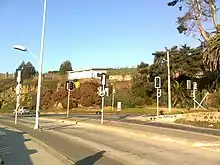
General road rules
- It is mandatory to put on seatbelts before driving a car.
- It is not allowed to eat, smoke or have your phone while driving.
- Beware! Visitors from the U.S. and Canada must know that right turns on red are banned in Chile.
- Pedestrians always have the right of way, especially at crossings.
- Always carry proper identification, including your driver's license and passport or RUT card.
- Make sure your car has Permiso de Circulación, or vehicle registration certificate.
Carabineros and traffic stops
Traffic stops are common in Chile. Carabineros (traffic police) frequently set up roadblocks for random checks. They are not to worry about as long as you have all the documents previously mentioned and haven't been driving under the influence. You must never try to bribe the Carabineros as this would only lead to trouble! The Carabineros are unlikely to speak in any language other than their native Spanish.
Signage
Chilean road signage is fairly consistent throughout the country and is usually inspired from the United States, but also uses both red ring and blue circle for mandatory actions (former as in the rest of Latin America and the latter as in Europe) and red ring with a red slash for prohibited actions. Road signs are written in Spanish, the official language of the country. Unlike the U.S., the majority of road signs in Chile are icons rather than words.
Chile also uses blue squares to indicate services or a starting/ending motorway.
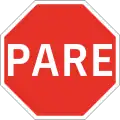 Stop
Stop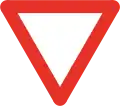 Give way
Give way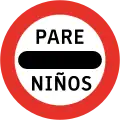 Stop and wait until children have finished crossing
Stop and wait until children have finished crossing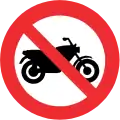 No motorcycles
No motorcycles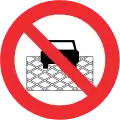 Do not block intersection
Do not block intersection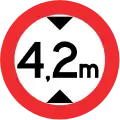 No entry to vehicles over 4.2 m (14 feet) high
No entry to vehicles over 4.2 m (14 feet) high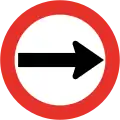 Turn right only
Turn right only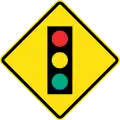 Traffic lights ahead
Traffic lights ahead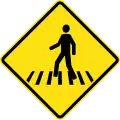 Pedestrian crossing
Pedestrian crossing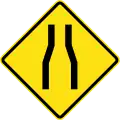 Road narrows
Road narrows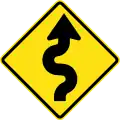 Winding road
Winding road
Keep right

You have to keep right while driving in Chile. This is true for visitors from countries which drive on the right including the U.S. Visitors from Australia, New Zealand and other countries driving on left must concentrate to prevent accidents.
Speed limits
.svg.png.webp)
Speed limits are white discs with red circle as a legend, as in most of the world. The national speed limit for highways in Chile is 120 kilometres per hour (75 miles per hour), which, in this case, only applies to cars and motorcycles. Buses and trucks have a speed limit of 100 kilometres per hour (62 miles per hour), which, you should not be worrying about. Other speed limits are:
- 50 km/h (31 mph) within towns
- 60 km/h (37 mph) outside of built-up areas, and typical limit for automobiles and motorcycles
- 90 km/h (56 mph) for trucks or automobiles with trailers
.svg.png.webp)
Occasionally, there is a minimum speed sign in Chile, with a white rectangle with black text reading "MINIMA".